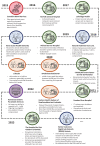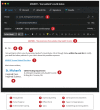Cyberattacks on Canadian health information systems
- PMID: 37984938
- PMCID: PMC10662499
- DOI: 10.1503/cmaj.230436
Cyberattacks on Canadian health information systems
Erratum in
-
Correction to "Cyberattacks on Canadian health information systems".CMAJ. 2023 Dec 17;195(49):E1728. doi: 10.1503/cmaj.231690. CMAJ. 2023. PMID: 38110221 Free PMC article. No abstract available.
Conflict of interest statement
Competing interests: Alun Ackery is provincial medical director with CritiCall Ontario. No other competing interests were declared.
Figures



References
-
- How Canada Compares: Results from the Commonwealth Fund’s 2019 international Health Policy Survey of Primary Care Physicians. Ottawa: Canadian Institute for Health Information; 2020:1–78. Available: https://www.cihi.ca/sites/default/files/document/cmwf-2019-accessible-re... (accessed 2023 Oct. 29).
-
- HC3 intelligence briefing update dark web PHI marketplace: overall classification is unclassified. Washington (DC): The U.S. Department of Health & Human Services; 2019:1–13. Available: https://content.govdelivery.com/attachments/USDHSFACIR/2019/04/25/file_a... (accessed 2023 Oct. 29).
-
- The state of ransomware in healthcare 2021. Abingdon (UK): SOPHOS; 2021:1–16. Available: https://assets.sophos.com/X24WTUEQ/at/s49k3zrbsj8x9hwbm9nkhzxh/sophos-st... (accessed 2023 Oct. 29).
-
- The impact of ransomware on healthcare during COVID-19 and beyond. Traverse City (MI): Ponemon Institute; 2021. Available: https://www.censinet.com/wp-content/uploads/2021/09/Ponemon-Research-Rep... (accessed 2023 Oct. 29). Login required to access content.
MeSH terms
LinkOut - more resources
Full Text Sources
